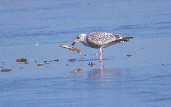|
European Herring Gull Larus argentatus
|
 |
The European Herring Gull belongs to a complex group of birds from a taxonomic point of view. On the one hand it can be
regarded as one end of a ring of similar gulls that circle the Arctic showing gradual changes in appearance (a "cline") until, at the other
end of the ring we find the Lesser Black-backed Gull Larus fuscus. On the other hand the Yellow-legged Gull Larus cachinnans, now regarded as a full species, used to be regarded as a
subspecies of Herring Gull.
|
 |
The adult European Herring Gull has pale grey upperparts, a white head (streaked in autumn) and a yellow bill
with red spot. Herring Gulls have pink legs at all ages. The second year birds in the second and fourth photos have pale grey beginning to show
through the spotted brown and has a pink base to its dark bill with which, in the 4th photo, it is trying to open a razor clam. Note that the
underwing is pure white compared to the Lesser Black-backed Gull. |
 |
While fish and shellfish comprise a large part of their diet, Herring Gulls will eat almost anything as well as
being predators of small birds, eggs and rodents. They are found in large numbers at rubbish dumps and are regarded as pests when numbers get out of
hand.
There is an illustration in HBW, Volume 3, Page
607.
|
 |
 |
 |
 |
 |
 |
 |
 |
 |
|
 |
|
|
|












